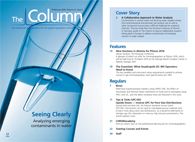Detection Markers in Trypanosomiasis
Researchers from Imperial College London and the University of Aberdeen have identified disease markers for Human African Trypanosomiasis (HAT), commonly known as “sleeping sickness”. Using reversed-phase ultrahigh‑performance liquid chromatography coupled to mass spectrometry (UHPLC–MS) and proton nuclear magnetic resonance (1H NMR) spectroscopy researchers found 53 discriminatory metabolite markers.
Photo Credit: Stocktrek Images/Getty Images

Researchers from Imperial College London and the University of Aberdeen have identified disease markers for Human African Trypanosomiasis (HAT), commonly known as “sleeping sickness”.1 Using reversed-phase ultrahigh-performance liquid chromatography coupled to mass spectrometry (UHPLC–MS) and proton nuclear magnetic resonance (1H NMR) spectroscopy researchers found 53 discriminatory metabolite markers.
Sleeping sickness is prominent throughout large portions of Africa causing significant death and disease. Infection is caused by two subspecies of Trypanosoma brucei (T.b.) transmitted via tsetse fly vectors. T.b. gambiense is endemic within Western Africa while T.b. rhodiesiense is more prominent within Eastern and Southern Africa. The latter is typically fatal in less than a year if infection is untreated.
Routine screening and rapid diagnostic tests are available for T.b. gambiense. However, no such test exists for T.b. rhodiesiense, making diagnosis the biggest challenge in the treatment and control of this disease.
To produce an effective diagnostic test researchers required markers that differentiate infected individuals from uninfected individuals to use in diagnostic screening. 1H NMR was used to screen plasma for variant surface glycoproteins (markers). Previous research had highlighted marked changes in plasma lipids in infected individuals.2,3,4 Consequently reversed-phase UHPLC–MS was used to characterize lipid profiles.
Large variations were found in plasma profiles, specifically in lipid and amino acids, through both 1H NMR and reversed-phase UHPLC–MS. Sixteen disease markers were identified by NMR while UHPLC identified a further 37 markers. The authors hope these markers can be used to create a novel and rapid screening procedure for T.b. rhodiesiense. - L.B.
References
- Lamour et al., PLoS Negl. Trop. Dis. 9(10), e0004200 (2015).
- Wang et al., Proc. Natl. Acad. Sci. USA 105, 6127–6132 (2008).
- Rouzer and Cerami, Mol. Biochem. Parasitol. 2, 31–38 (1980).
- Nakamura, Vet. Parasitol. 80, 117–125 (1998).

New Method Explored for the Detection of CECs in Crops Irrigated with Contaminated Water
April 30th 2025This new study presents a validated QuEChERS–LC-MS/MS method for detecting eight persistent, mobile, and toxic substances in escarole, tomatoes, and tomato leaves irrigated with contaminated water.

.png&w=3840&q=75)

.png&w=3840&q=75)



.png&w=3840&q=75)



.png&w=3840&q=75)








